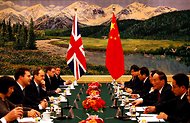The crowd, which organizers said included as many as 3,000 middle-aged men and women from across China, appeared to overwhelm the police. Officers largely stood by as the protesters held aloft signs saying, “I’ve been wronged.”
It is not the first time the former bank tellers, accountants and branch managers have sought to publicize their grievances, which stem from a restructuring of China’s four largest banks as they prepared to go public, forcing out about 400,000 people during the decade-long purge. Many of those fired were over 40, and some were nearing retirement.
Analysts, citing bloated work forces, say the downsizing was a necessary component of a modernization effort that transformed the country’s socialist-era banking sector.
According to the London-based Banker magazine, four Chinese financial institutions are now among the world’s top 10 largest banks. The number one spot belongs to Industrial and Commercial Bank of China, or ICBC.
News of soaring profits have only angered those who were let go during the streamlining drive. Many say they were offered paltry compensation; those who refused the packages were fired anyway.
“We’re just asking for fairness, seeking to regain our former jobs or receive compensation,” said Zhang Guoxi, one of the protest organizers and a former ICBC employee.
Mr. Zhang, who gave a brief speech to the crowd, said many would-be protesters were thwarted by the police before they could reach the State Bureau for Letters and Calls, a forbidding structure south of Tiananmen Square that draws throngs of petitioners each day — as well as men, employed by local governments, whose job it is to stop them from entering the building to file their grievances.
Public security officials responded with a show of force that included scores of public buses. But rather than herd protesters onto the buses, the police stood by as the crowd chanted slogans like “We want to eat.” At one point, an officer taunted the crowd, shouting, “Then go back home and ask your mother for food.”

Yuan Chang contributed research.
Article source: http://www.nytimes.com/2013/07/23/world/asia/former-bank-employees-protest-in-beijing.html?partner=rss&emc=rss

